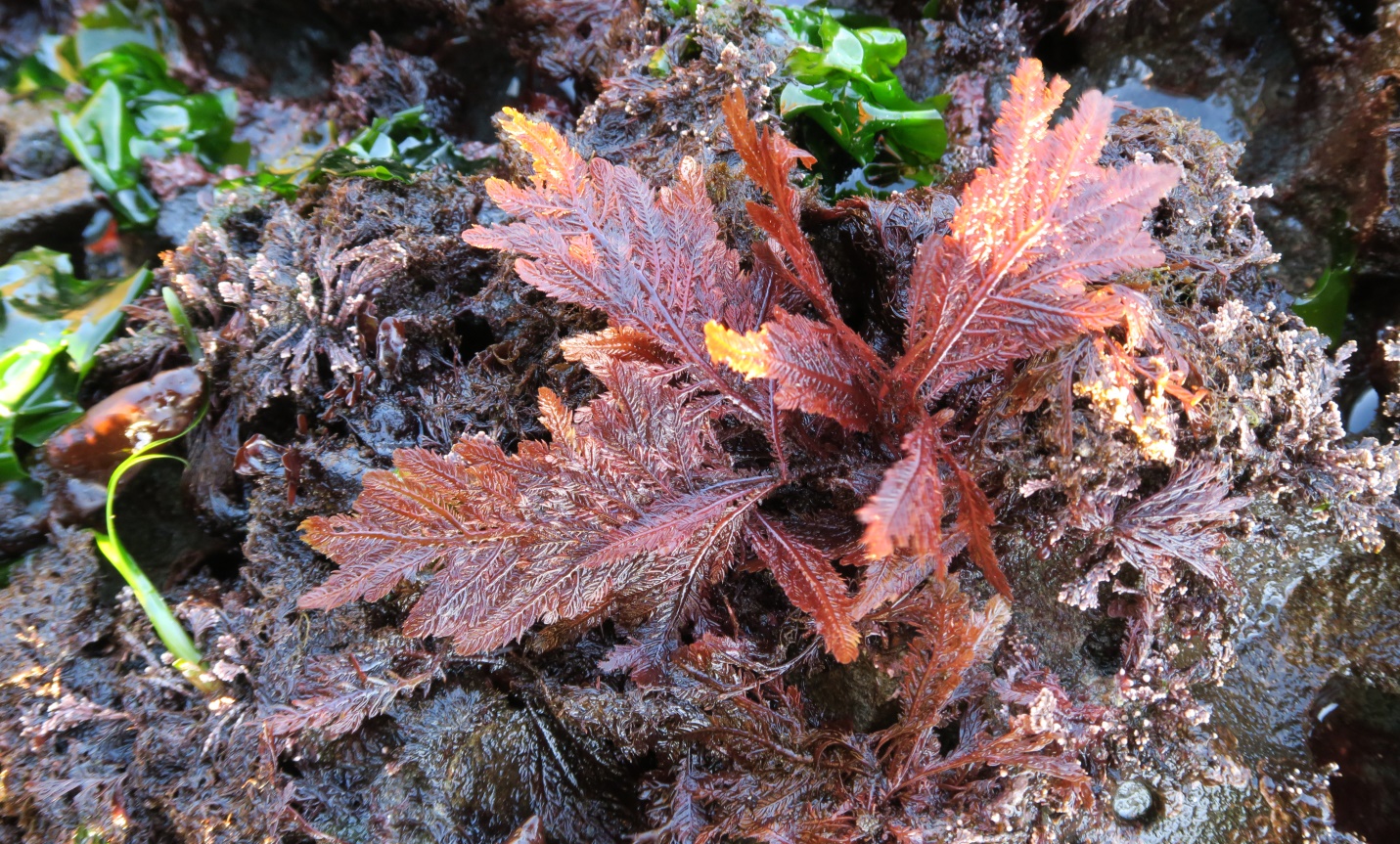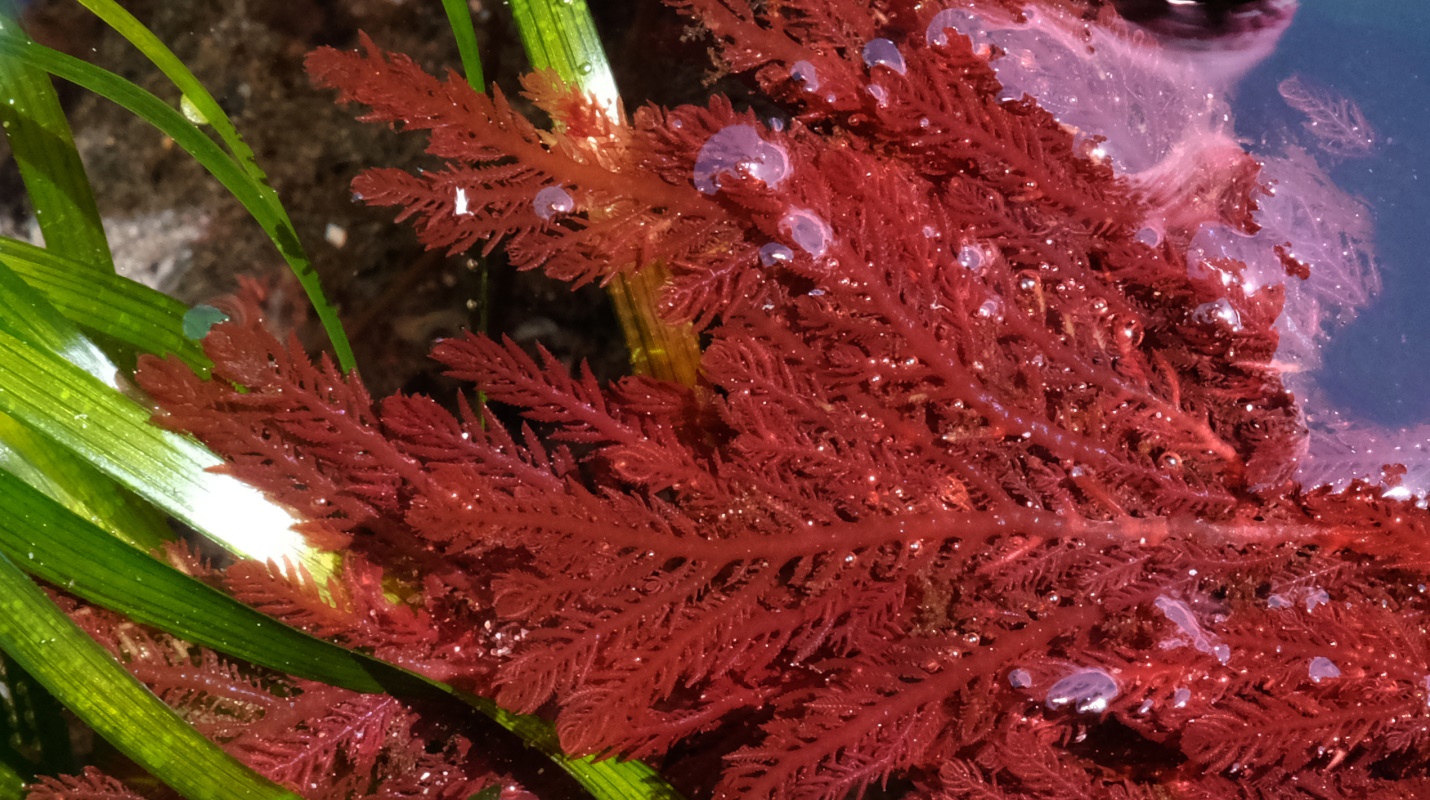
Ptilota serrata
Northern Sea Fern
6 April 2022
12:20pm
French Beach, Juan de Fuca Strait, B.C., Canada.
Tide: 2.3 feet at 12:22 PDT (measured at Sheringham Point Tidal Station)
Conditions: Partly cloudy (30% cloud cover), wind SSE 20 km/hr, sea choppy, moderate SE swell, humidity 79%, 9˚C.
Moon: Waxing Crescent (27.4%); Previous Phase, New Moon, 31 March 2022 at 11:24pm PST; Next Phase, First Quarter, 8 April 2022 at 11:47pm.

Figure 1: Ptilota serrata – remarkably rigid thalli grow on the sandstone shelf here that is crowded with macroalgae; French Beach, Juan de Fuca Strait, BC, Canada. February 12, 2022. Photo ID: 27135 ©Seaweedwhisperings.com
Person 1:
Living on the edge.
Orderly branching.
Seems conservative, but is adventurous.
Can hide amongst others, but ‘flashes’ (flashes means popping out of the background, and then retreating).
A paler, brighter red than most other seaweeds.
I keep wanting to return to the same individuals; I did feel I wanted to explore others, but then also wanted to quickly return to the one’s I’d just left.
Is this seaweed repetitive in its actions and deeds – “came back for more”?
Messy printing – hides real self – cryptic messaging. What it sends out is difficult to decipher.
Person 2:
A ‘red’ growing amongst other reds.
Hidden in plain sight.
Where to find you…, in the exposed splash zones and near the edges and crevices of this sandstone ledge, not someplace smooth and calm like the adjacent tide pools.
Flat, growing on one plane.
Finely and neatly patterned branching.
Quality of red color is different.
Fairly strong mid rib.
So FLAT, as if pressed into one plane.
If the wind lifts you up, all of you stands lifted, no flopping.
But if the surf washes you down, then pressed and flattened and well-hidden you become once again.
Side branches only reach out so far and no more. Don’t dare!
Overall shape is interesting. Thalli form as broad fans of red foliage that are, for their size, fairly rigid/firm – they maintain their shape when out of water.
What do you like about the wilder places, the more exposed surf zone?
It’s hazardous; we can’t linger long here to observe you without risk to the safety of our person and belongings – camera, binocular, lenses, etc. Ah…, this is one reason why you live here. No one lingers long with you.
Hazardous to visitors, yes, but to you also. Already you have broken down, broken off to fewer and shorter stems that I saw here in February. Your population is much smaller than two months ago.
Are you simply a bright and brave “early bird”? Show up early and perish young, or too early?
April 6th, barely springtime…, and already broken.
2 days later, starting to transcribe in situ notes and moving further along with the Whispering:
I typed a totally wrong species name for the header of this document.
Wrong name being used/given has happened in the past regarding a very closely related species.
Even if I had the name, I found it hard to remember, I kept forgetting it and needing to look it up again.
All in all, something about the energy of this seaweed wants to be very much incognito.
Identity hidden.
Can assume ‘false’ identities.
Even in situ, Person 1 wanted to return again and again to previously visited specimens and the drive behind this was an attempt to figure out who Ptilota really was. Person 1 recalls “trying to figure out this thing that doesn’t seem to be really itself”.
With age, identity also becomes obscured by battering of the environmental forces – branches break off, distinguishing features wear away.
The combined themes of ever-present danger and hiding (or hidden/assumed identity) – like an undercover policeman or a spy?

Figure 2: Ptilota serrata – this individual is bleaching paler red and floating in a tide pool. Details of the serrations along the branch edges can be seen at this larger than life size magnification; French Beach, Juan de Fuca Strait, BC, Canada. April 6, 2022. Photo ID: 27136 ©Seaweedwhisperings.com
Discussion:
Our opportunity to visit French Beach this day was just after a very big spring storm (which brought winds of 50 km/hr gusting to 90 km/hr for over 24 consecutive hours, much rain and also pelting hail at times) had moved through our area. The storm had passed but the sea was still not settled – the remnants of the storm’s energy was lingering.
Splash zone, is that how Ptilota survives the tide going out – because it will still get sea spray during lower tides.
Yearns to be adventurous, really likes the idea of being adventurous, and fearful to venture out.
Breaking off young/early – or older individuals have been broken before; that’s a reason to be fearful, there’s this memory of having been battered before.
This energy may be strongly expressed in youth – teens and early 20’s. There’s a daring and sense of invincibility that characterizes them. If they live to older age, it generally is with a learned caution, they can look extremely conservative and they remain there out of fear. They “slim down”, stay with the narrow “tried and true” and vigilantly avoid most outside influences.
The wilder places, the exposed or even hazardous zones, intuitively they are drawn here and it here that their personality is shaped, IF they survive.
Broken.
Disrupted.
Sometimes can pick up the thread again, sometimes it is completely lost.
Feeling like walking headfirst into a gale…, that one has to hold on tight or your concentration will be blown away.
There was a dominant energy during this Whispering, one that was pervasive and lingering, of broken efforts; this was at times mildly irritating, at other times quite impactful/damaging. When this influence ‘lifted’ from our experience we both expressed relief, and enjoyed the calm. Later we thought, oh my, to live with those battering forces all the time would really be stressful.
Extremes in the natural environment trim this seaweed down.
Branches only grow so long; if longer, they would be broken away.
It can be also numbed or dumbed down - your adventurous spirit is clipped to a very low level.
Looking very closely at the tiny branches, one discovers neat serrations along the edges.
Like a fine short comb or saw teeth – this is a defensive feature.
Once the daring/adventurous spirit is clipped, the person retreats to a neat and orderly appearance. Their personality often can feel ‘distant’ or reserved, and relatively benign. However the teeth do exist, but only come into use when another intrudes too closely – penetrates the façade.
Repetitive in action and deeds; if living an undercover life or a life that is ‘a fabrication’ then one probably does need to keep running the story of their false identity continuously, so that it is firmly imprinted in their own awareness and therefore believable to others.
Living on the edge, in dangerous/hazardous areas, pretty much guarantees that, yes, others can’t linger long and get to know you very well at all, Ptilota serrata. It also means that you can’t explore your own identity in a very full or relaxed way either. You’re too often in “fight or flight” and “face-the-danger” mode to have the chance to peek over the wall of that external persona of yours to see the rest of your SELF.
This can be one significant pitfall as you can become firmly “at one” with your own false/assumed/partial identity. Who are you then, Pitlota? Where would one look to find YOU?

Figure 3: One green and at least four different red algae including Ptilota serrata are crowded here on the surf swept sandstone shelf at French Beach; Juan de Fuca Strait, BC, Canada. April 6, 2022. Photo ID: 27137 ©Seaweedwhisperings.com
Biology & Natural History Information:
Description:
Thallus is dark red, dull and finely branched. It can reach 25cm tall. Branching is in opposite pairs. Both branchlets have the potential to elongate and branch again, and later to produce reproductive cells, but usually one pair develops ahead of the other. This can give an ‘alternate’ look to the branching as one of a pair will be larger, and the other smaller. Fine serrations line both margins of the branches.
Habitat:
This perennial is mostly found on rock and less often on other macroalgae and occasionally even on animals in the low intertidal to subtidal regions. It is reported to favor semi protected and semi exposed habitats.
North Pacific Distribution:
Bering sea and Aleutian Islands to Oregon; Korea; Japan; Russia.
Remarks:
The species name from the Latin adjective – serrated. Stearn (1973) noted that the serrations are saw-edged with teeth pointing forwards.
Classification:
Phylum: Rhodophyta
Class: Florideophyceae
Order: Ceramiales
Family: Wrangeliaceae
Genus: Ptilota
Species: Ptilota serrata Kützing 1847
Former name: Ptilota pectinata
![]()